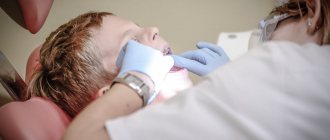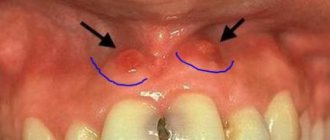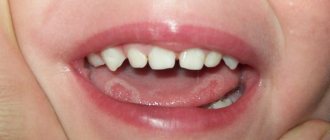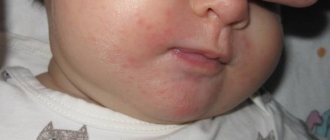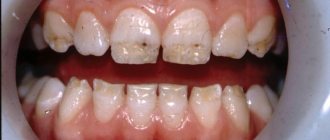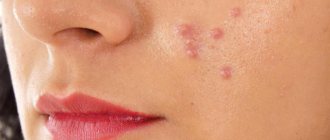Swelling of the nasal mucosa in a child is a characteristic symptom of a number of diseases. It represents a protective reaction to pathological changes in the body. Swelling occurs due to increased capillary permeability and accumulation of fluid in the tissues of the cavity. The lining of the respiratory tract in this case becomes a place for bacteria to accumulate. As a result, the child cannot breathe, his mood deteriorates, sleep and appetite disappear. In some cases, there is a threat of inflammation of the bronchi.
In the absence of sneezing and watery eyes, most parents do not attach importance to this problem. However, nasal congestion can occur without obvious signs of a runny nose. If the symptoms are ignored, it provokes a number of complications, including respiratory arrest. It is necessary to relieve swelling of the mucous membrane for basic safety reasons.
- Drops for vasoconstriction
Causes of the disease
There are several reasons for swelling of the nasal mucosa in a child.
Allergic reaction
Allergens may include:
- pet fur;
- mold and other microorganisms;
- pollen of grasses and plants;
- pile from carpets, rugs;
- medicines and food;
- dust and other household allergens.
Allergic swelling of the nose has distinctive signs. The moment the child comes into contact with the allergen, itching occurs, after which sneezing and watery eyes begin. The sense of smell is impaired, the voice changes.
Features of physiology
In newborn children, nasal swelling is a natural physiological process. The mucous membrane is not able to withstand the load, since in the womb of a woman the respiratory system does not work. The lack of formed regulatory processes leads to swelling of the nasal membrane. Over the next two years, the nasal passages widen and the problem disappears.
Polyps
Polyps are abnormal protrusions of tissue above the nasal mucosa. They are benign and do not cause pain when pressed. Outwardly they resemble a bunch of grapes. Doctors believe that the main reason for the formation of polyps is the anatomical imperfection of the structure of the body. The disease is characterized by nasal congestion and constant mucous discharge. The child experiences a decrease in sense of smell, disruption of diet, and deterioration in concentration. There is tinnitus and snoring. Lack of treatment leads to gradual closure of the nasopharynx.
Overgrowth of adenoids
Adenoids are tonsils in the nasopharynx, consisting of lymphoid tissue. During the inflammatory process, oxygen supply in them is disrupted. This provokes swelling of the sinuses, as well as signs of hypertrophy. Among the reasons for enlarged adenoids:
- low immunity,
- frequent colds,
- lack of useful microelements in the body.
Swelling of the nose is accompanied by a runny nose, a nasal voice and decreased hearing.
Mechanical injuries
The causes of nasal swelling in a child may include various injuries:
- closed,
- open,
- combined,
- with bone displacement
- without bone displacement.
Mechanical injuries often occur in children. These are evidenced by wounds and deformations of the nose. If breathing suddenly becomes difficult, and swelling is accompanied by pressure in the cavity, the fact of a foreign body entering the nose should be excluded. A small object can remain in the mucous membrane for several days. To rule out asphyxia, consult a surgeon. He will conduct a visual examination and refer you for x-rays.
Infectious process
Viruses are another cause of swelling. Almost all respiratory diseases begin with nasal congestion. This means that the infection has entered the body, but is in an inactive state. Its development is facilitated by factors that reduce immunity. The infectious process is accompanied by profuse lacrimation, as well as a complete cessation of breathing. Yellow mucus appears.
Runny nose during teething - is this normal?
It is generally accepted that teething can cause symptoms such as a runny nose, fever, pain, irritability and trouble sleeping.
However, scientific evidence for these beliefs is not clear-cut. Scientists are divided on the connection between these symptoms and teething. While many experts agree that teething does not cause nasal congestion or runny nose, the stress associated with teething can make babies more susceptible to various illnesses. In this article, we'll look at the connections between teething and several symptoms, including a runny nose. We'll also discuss possible causes of runny nose in babies and find out when to see a doctor.
Irina Nazaruk Family doctor, pediatrician
With teething syndrome, swelling of the nasal mucosa is often observed. If there is nasal congestion and a runny nose, then you can rinse your nose more often, it is better to irrigate it (sprays: Quix, Delufen). For prevention, rinsing is recommended 2-3 times a day. If the swelling is very severe, then vasoconstrictor drops are needed, for example, Nazivin 0.01% before a year, and 0.025% after a year, 2 times a day.
Can teething cause a runny nose?
Typically, the first tooth emerges in infants at 6 months of age. By 30 months, as a rule, children already have a full set of 20 teeth in their mouths. The teething period for each tooth takes about 8 days. It begins 4 days before the tooth passes through the gum and lasts 3 days after that. This process is known as tooth eruption. child's temperature
Many parents and caregivers notice problems such as a runny nose or fever that precede the appearance of a new tooth. But some experts believe these symptoms are not directly related to teething.
Seattle Children's Hospital warns that teething does not cause a runny nose, fever, diarrhea or rash. However, some experts believe there may be an indirect link, and that the stress of teething may make babies more vulnerable to infections, which cause symptoms such as a runny nose.
As stated earlier, between the ages of 6 and 30 months, children develop teeth and the immune system goes through a number of changes. During this period, the protection that the baby received at birth, and possibly through breast milk, begins to weaken. At the same time, children begin to interact more with the outside world, and accordingly, the risk of various childhood diseases increases. In addition, do not forget that during teething, babies begin to put various objects in their mouths, which increases the chances of harmful microbes entering the body.
What are the main symptoms of teething?
The main signals of teething are:
- Salivation
- A rash on the face that occurs when saliva containing small food particles gets on the skin and irritates it Increased urge to chew things
- Restlessness
- Moderate gum soreness, which can occur because germs in the mouth become trapped in the gum cavities, but not all children experience this
- Teething is unlikely to cause:
- Excessive crying
- High temperature
- Loss of appetite for liquid foods
- Disturbed sleep
- Diarrhea or loose stools
- Vomiting
- Cough
Causes of runny nose in children mother and child
The nose regularly produces mucus, a fluid that keeps the inside of the nose moist and traps germs, preventing them from entering and spreading. The body usually sweeps the mucus back into the throat and swallows it. A runny nose, or rhinorrhea, occurs when excess mucus is expelled through the nose instead of running down the throat.
Mucus can be thick or thin, clear or opaque, and a runny nose usually goes away on its own. Some causes of runny nose in children include:
- Cold weather. It can cause a reaction that causes the body to produce more mucus.
- Cry. Tears can pass through the nasal cavity and into the nose.
- Irritation. A runny nose can be the result of exposure to allergens or irritants such as smoke and pollution. Colds and flu. These viral infections can cause the nasal cavity to fill with mucus, creating an obstruction that leads to a runny nose.
- Blockage. A foreign body can enter the nose and lead to similar results.
- Sinus infection. The sinuses are air cavities in the bones of the skull that communicate with the nasal cavity. When sick, they can become filled with infected mucus, and the resulting buildup can cause inflammation of the sinuses. However, a baby's sinuses are not fully developed and this type of infection is extremely rare.
- Adenoid infection. Adenoids are tissue at the back of the nose. In children, infection in this tissue can lead to a runny nose.
The following reasons are less common:
- Choanal atresia. This occurs when bone or tissue closes off the back of the nose. If both sides are blocked, doctors usually detect it immediately after birth. However, if atresia affects only one side, it may go undetected for some time.
- Pear-shaped nasal aperture. In this case, the anterior bony opening of the nasal cavity is limited by the nasal notches of the upper jaws and the anterior edges of the nasal bones.
- Deviated nasal septum: The nasal septum is a wall of bone and cartilage that separates the two sides of the nose. In some cases, the septum may bend to one side and create an obstruction. A person can be born with this condition, as well as get it as a result of an injury to the nose.
- Nasal polyps. These small grape-like growths in the lining of the nose can also lead to a runny nose.
- Cyst or tumor. In rare cases, these conditions can cause a runny nose. Malignant tumors most often form in one part of the nose.
When should you see a doctor?
The doctor should check your child if he or she is constantly restless or has a high fever. These symptoms can occur with conditions such as an ear infection.
If your runny nose persists, it may indicate an underlying health problem, such as one of the ones listed above. If your baby's runny nose persists for more than 10 days, be sure to consult a doctor so that he can provide the necessary medical care.
Parents often attribute runny noses and other symptoms to teething. However, there is no evidence that teething causes a runny nose, fever, diarrhea, vomiting or excessive crying. These symptoms are most likely caused by environmental exposure and various childhood illnesses.
If your child is restless, develops a fever, or has other severe or persistent symptoms, call your doctor. It is very important to share your concerns about your child’s health with a specialist in a timely manner.
Symptoms and signs
Symptoms of sinus swelling in a child include:
- External increase in cavity tissue.
- Constant feeling of nasal congestion.
- Lack of normal breathing.
- Complaints of dizziness, pain in the temples.
- Increased body temperature.
With allergies, severe swelling of the nose is accompanied by sneezing. Redness is observed on the child's skin. Transparent mucus comes out of the nose.
The presence of infection provokes malaise, weakness and drowsiness. Babies experience lacrimation and snoring during sleep.
A bruise forms at the site of a mechanical injury. It is characterized by swelling and pain during palpation, and in some cases, internal hemorrhage. Lack of treatment increases the likelihood of complications such as loss of smell and purulent discharge.
Causes
Nasal congestion in newborns is caused by imperfections in the anatomical structures and functioning mechanisms of the upper respiratory tract. Single-celled glands of the mucous membrane periodically show hyperactivity, producing excess secretions. Due to the narrowness of the nasal canals, mucus is subject to stagnation and thickening. This is why babies often have a stuffy nose. Physiological swelling of the nasopharynx is also observed during teething from 6 months of age.
At the same time, pathological factors can become the cause of hypersecretion and swelling of the soft tissues of the nose:
- viral and bacterial infections;
- allergic reactions;
- injuries or congenital defects of the nose (deviated septum, choanal atresia);
- polyps in the paranasal sinuses;
- hypertrophy of the nasopharyngeal tonsil (adenoids).
Diagnosis of the disease
Diagnosis begins with a visit to the pediatrician. If the child does not feel improvement within a week, the doctor prescribes a consultation with an otolaryngologist. The initial examination involves:
- history taking and manual examination, during which the affected area of the nasal sinuses is established;
- analysis of urine and blood tests, which allows you to determine the severity of edematous changes;
- laboratory diagnostics, which involves the use of various cytological methods.
If necessary, the specialist will use the following research methods:
- Rhinoscopy.
A method of examining the cavity in which the doctor inserts closed mirrors into the nasal opening and then opens them inside. - Microrhinoscopy.
This method uses a self-supporting mirror, which allows the doctor to manipulate with both hands and take photographs of the nasal cavity. - Diaphanoscopy.
Transillumination of the paranasal sinuses with a beam of light to identify skin formations. - Fiberendoscopy.
Examination of the nasopharynx using an endoscope with a diameter of up to 3 mm. If an allergy is suspected, allergological and immunological studies are carried out.
Preventive measures
To make it easier for your baby to breathe through the nose and increase resistance to respiratory infections, you should:
- Regularly ventilate the room, perform wet cleaning, and ensure air humidification up to 60-70%.
- Get rid of “dust collectors” - carpets, woolen rugs and blankets, soft toys, down pillows.
- Avoid contact with pets.
- Regularly, morning and evening, perform nasal hygiene by instilling 2-3 drops of the isotonic drug Aqualor Baby into each nostril.
Treatment of nasal swelling in a child
The process of treating nasal swelling without a runny nose in a child requires an individual approach. An experienced doctor will be able to recognize the signs of the disease and prescribe the correct treatment regimen.
Drops for vasoconstriction
The latest generation of antihistamines are represented by nasal sprays and drops. Sialor Rhino copes well with nasal congestion in children of all ages. The function of the drug is to narrow the blood vessels in the nasal cavity.
Advantages of Sialor Rhino:
- fast and effective results,
- long duration of action (up to 12 hours),
- three dosage options,
- no cross-contamination (contamination of the product during production),
- convenient use.
The basis of the drug is oxymetazoline, a local-spectrum alpha-adrenergic stimulant. "Sialor Rhino" is administered intranasally. Within a few minutes, it reduces the level of swelling of the mucous membrane in the upper part of the respiratory tract. Thanks to the opening of the paranasal sinuses, the child feels noticeable relief of his condition.
Antiseptics and antibiotics
For respiratory diseases, nasal swelling is relieved with antiseptics. Such medications help reduce inflammation and restore healthy microflora. For convenience, we recommend choosing antiseptics in the form of drops.
The use of antibiotics occurs when the mucous membrane is swollen due to an infectious disease. They have a powerful effect on the child’s body, so treatment should be carried out exclusively under the supervision of a doctor. Additionally, you can use ointments based on eucalyptus, mint and pine needles.
Nasal rinsing
Nasal rinsing allows you to achieve the following results:
- removal of excess mucus,
- softening of the crust in the cavity,
- cleansing the mucous membrane,
- removal of dust and allergens,
- facilitating the breathing process,
- relieving inflammation.
The washing procedure is quick and uncomplicated. It is used not only for medicinal but also for hygienic purposes. Washing is carried out using saline solutions, sea water, and antiseptics. Duration of treatment is up to two weeks.
Physiotherapy
The following physiotherapeutic procedures help reduce swelling of the nasal mucosa in the absence of a runny nose in a child:
- Inhalations.
With warm inhalations, the baby inhales the sprayed medicine through the nose. At home, essential oils and herbal infusions are used. Steam penetrates into inflamed areas of tissue, eliminates pathogenic organisms and reduces the level of swelling. - Ultrasound therapy.
It is the effect of ultrasound on the nasal sinuses. Sessions last from 5 to 10 days. The procedure helps to dilate blood vessels, normalize blood flow and increase tissue regeneration. - Laser therapy.
An alternative treatment method in which the affected area is exposed to optical radiation. The duration of the course is from 5 to 12 days.
Surgical intervention
Surgical intervention is practiced in advanced cases - when drug treatment has failed. The operation is performed to remove the foreign body, eliminate growths and polyps, and remove inflamed adenoids. It is performed in a hospital under general or local anesthesia. The recovery period is from two to five days.
Features of therapy for children under one year old
Treatment of young children should be approached with extreme caution. At this age, many drugs are contraindicated and most procedures cannot be performed.
Treatment should be carried out by a specialist who, based on the research carried out, can prescribe the following groups of medications approved for use in babies under one year of age:
- Vasoconstrictors. Milder nasal drops containing a small amount of active substance are prescribed. The therapeutic effect is based on relieving congestion and eliminating a runny nose. The drugs can cause addiction, so the duration of the course should not exceed 3-5 days. Frequency of use up to 3 times a day. Nazol Baby, Nazivin Sensitive may be prescribed.
- Based on sea salt. Such nasal drops are completely safe because they are based exclusively on natural ingredients. They have a gentle effect on the mucous membranes, improving breathing and overall well-being. They help fight a runny nose, but do not affect the cause of the symptom. Used as a complex therapy and daily cleansing of mucus from the nasal passages for the prevention of diseases. Effective representatives: Aqualor Baby, Otrivin Baby.
- Antihistamines. They are used if the cause of a runny nose and congestion is an allergen. Then, to relieve symptoms in infants, Histimet, Vibrocil, Zyrtec are prescribed. Such drugs can relieve swelling, inflammation and normalize respiratory function.
When using medications for children, it is necessary to monitor the dose and duration of the course. They must not be exceeded. If the causes of nasal congestion in a child are viral, colds and other conditions, other medications may be prescribed. They try to prescribe drops with the most natural composition, fewer contraindications and side effects.
Prevention
We recommend that you take timely measures to prevent your baby’s nasal congestion:
- monitor your child’s diet and sleep;
- take him out into the fresh air more often;
- avoid hypothermia;
- wean your child from bad habits (thumb sucking, nail biting, etc.);
- humidify the air in the apartment;
- do not use vasodilator drops;
- avoid mechanical injuries and damage;
- Avoid contact with external allergens.
Experts advise focusing efforts on improving the functions of the immune system. It is important to carry out timely prevention of respiratory diseases. Remember that following basic rules for caring for your baby’s health will help avoid swelling of his nasal cavity.
Symptoms
Obstruction of the nasal canals negatively affects the quality of life of the baby - the sucking reflex is disrupted, dyspepsia occurs, tearfulness and sleep problems are noted. Let's consider the main forms of nasal breathing disorder in an infant and the accompanying symptoms.
Physiological rhinitis
Until about 3 months of age, one of the main causes of nasal congestion in a baby is a physiological runny nose. Its symptoms:
- Moderate amount of clear secretion in the nasal canals.
- The so-called “grunting” nasal breathing.
- No fever or intoxication.
- There are no signs of conjunctivitis, hyperemia or swelling of the nasopharynx.
Problems with nasal breathing in the morning are often caused by insufficient air humidity in the room. To optimize the microclimate, humidifying devices are used or wet towels are placed near the child's seat. Normalization of breathing during the day indicates that the main problem was dry air.
If a baby's nose gets stuffy at night, then, as a rule, this indicates hypersecretion of the nasal mucosa. In addition to difficulty with nasal breathing, the exudate, going down the respiratory tract, provokes a dry cough.
Obstruction of the nasal passages makes breastfeeding difficult, so the baby refuses to eat, sleeps poorly and cries often. The absence of nasal breathing in an infant for a week is assessed as constant nasal congestion and requires specialist intervention.
Allergic reactions
Due to the immaturity of the immune system, allergic manifestations are much more common in infants than in adults. With allergic edema of the upper respiratory tract, an infant has a stuffy nose, copious discharge of clear mucus, dry cough, lacrimation, and conjunctival hyperemia.
Allergens most often include household microscopic mites, plant pollen, pet hair, household chemicals, and children's hygiene items.
Infection
Due to the lack of adaptive immunity, the infant is especially susceptible to respiratory diseases of a viral and bacterial nature. ARVI causes swelling and hyperemia of the nasopharynx, the nasal canals are filled with clear or whitish mucus, body temperature is 37.3-38⁰C, the baby often grunts through his nose, and a cough is often noted. Thickening of the mucus and the appearance of pus in it indicates a bacterial infection, the temperature rises above 38°C, and signs of intoxication are evident.
Adenoids and polyps
Hypertrophy of the nasopharyngeal tonsil occurs after suffering from colds, measles, sore throat, scarlet fever. An enlarged tonsil (adenoids) can cause nasal congestion in a baby from 2 months. Associated symptoms in this case will be decreased hearing, profuse nasal discharge, sleep disturbance, and tearfulness. The lack of competent treatment at the first signs of adenoiditis is fraught with chronic nasal congestion in the future.
Polyps, which are formed as a result of the growth of the nasal mucosa, interfere with the passage of a stream of air, sometimes block the mouths of the sinuses, which leads to the development of sinusitis.
Nasal congestion without runny nose
In some cases, swelling of the nasopharynx is not accompanied by rhinorrhea. Many experts attribute this to the dry air that the baby has to breathe. In addition, dry mucous membranes may occur in the following cases:
- when a foreign body enters the nasal cavity;
- at an early stage of viral diseases;
- when baby teeth are cutting;
- as a side effect of taking certain medications;
- with a deviated nasal septum and other nasal defects.
Some forms of allergies, sinusitis, and polyposis can occur without a runny nose.
